Hello Drivel Starved Nation!
As mentioned last week, we are opening the pre-order window for the following tools. Yes, I said tools.Why?
Well, if you haven’t noticed lately, shipping rates are getting crazy. Because a couple of these new tools are under $100, we are going to gang produce them so you save a few bucks. Cool eh?
First on the list is the new TS-1 v2. We were not planning on making this tool but enough of you pestered me about a smaller version of our new TS-2 v2 I green-lit the project. Please note there are not graduations on this square. The bead blasted stainless steel blade takes pencil marks beautifully so use this square when you want to story board a small project. I have always wanted a square that did this and now it is a few months away. This little guy is under $90 too.
The TS-1 v2 in aluminum sitting next to the upcoming Ts-2v2;
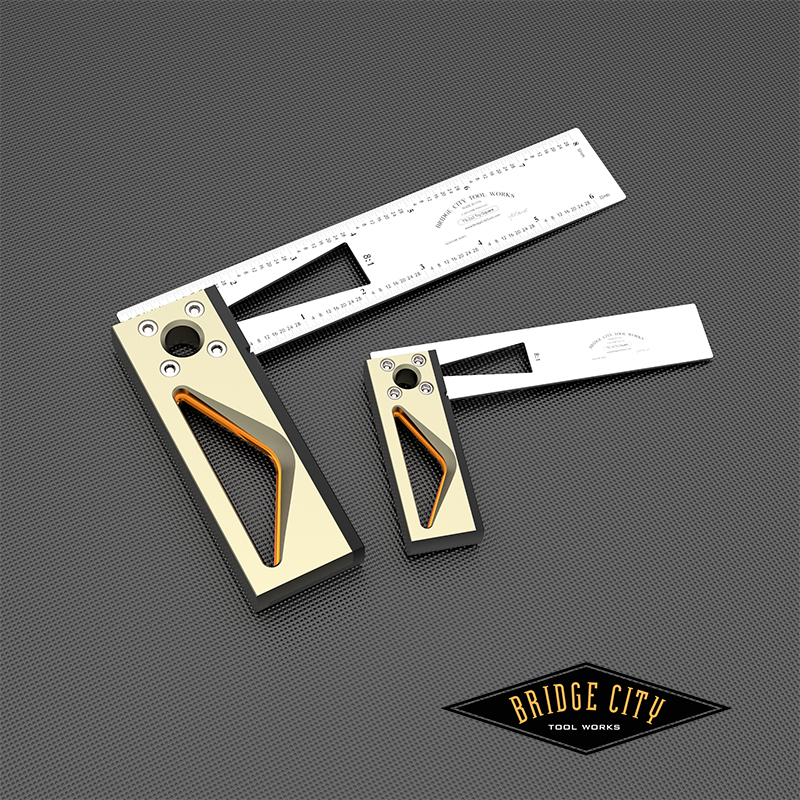
As part of our 30th Anniversary this year, we are going to make a limited run of 300 TS-1 v2’s in stainless steel. You have your choice of an orange detail or black. By the way, do you know why that detail is in the square in the first place? You will have to guess because I ain’t tellin’. It is cool looking that is for sure.
The TS-1 v2 Limited Edition Stainless Steel version;
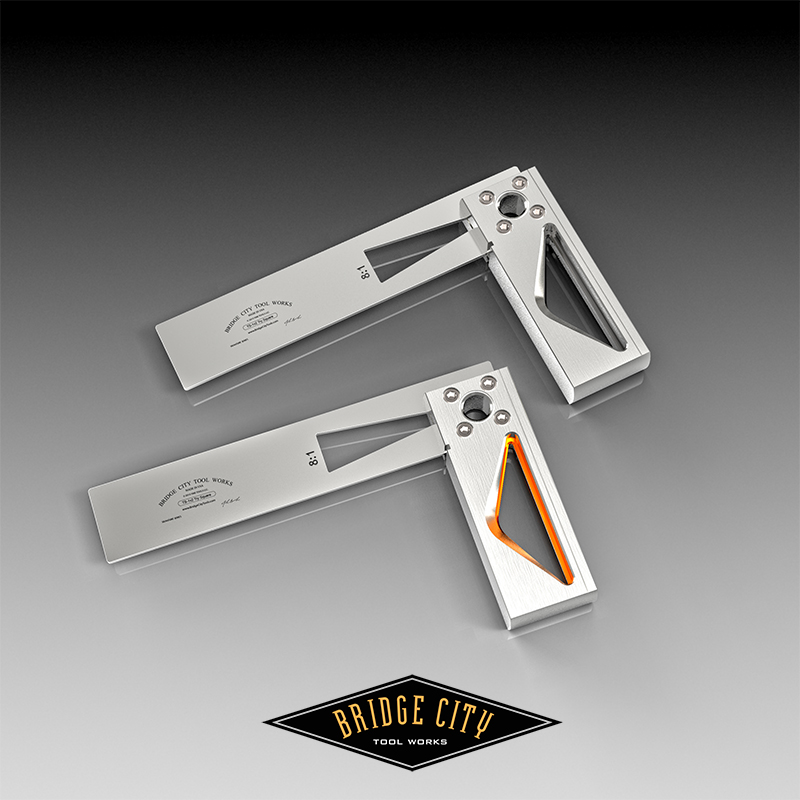
The crown jewel of this introduction is the new MT-2 Multi-Tool. NO, this is not the CT-15, so please don’t ask. It is similar however. It does feature 3 saddle squares and a positive lock bevel. Here are the notable differences; the blade is twice as long as the CT-15, the body is thicker and longer and the blade lock is redesigned. This is a limited edition, 30th anniversary tool that is really cool. While you are pondering the picture, have you figured out what the notch is for on the curved end of the blade? We will make as many of these as we receive orders and then … poof! Never again.
The MT-2 Multi-Tool (Blade is 7.5″ long);
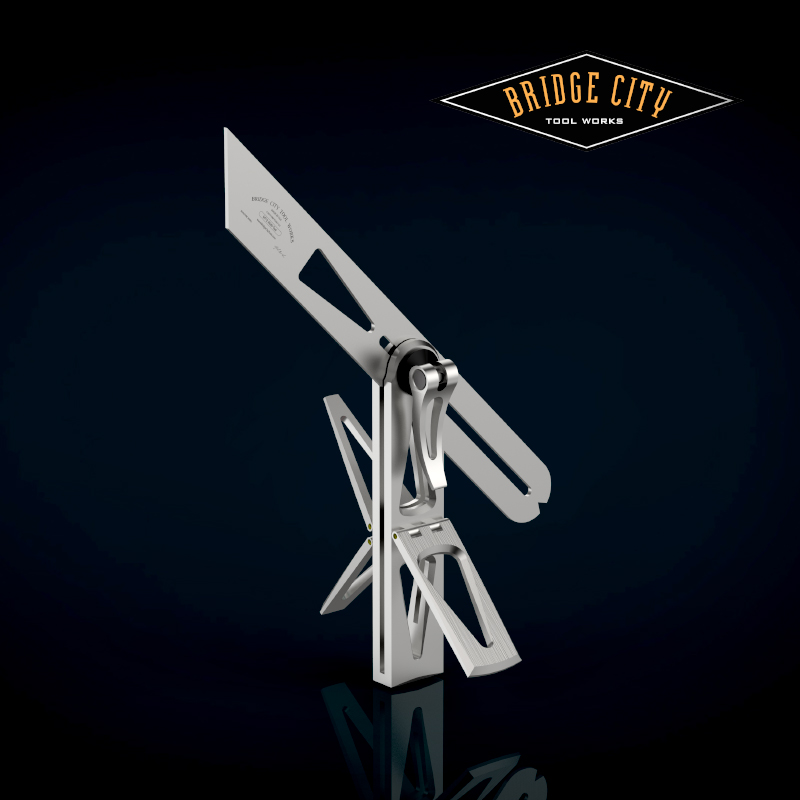
And now it is time for my rant about t-bevels. Many years ago, when there will still Mastodons snorting creek water in what is now known as Keokuk, Iowa, somebody invented a t-bevel that employed a wing-nut to lock the blade. This was an awesome invention with one exception, the wings were wider than the body of the bevel making it essentially useless. This pissed off somebody enough to invent an end-lock t-bevel which can never get in the way of bevel work, but it does make it hard to use the butt end of the bevel as a striking device. Come on! You know you have been tempted…
Anyway, we introduced the the TB-1 and 2 three decades ago and both employed face locking knobs. I had the pleasure of meeting many of our customers via the wood shows at the time and this is where I heard the following;
“Nice bevel, but I prefer and end-lock bevel.”
“Why?” I inquired.
“Well, the knob gets in the way.”
“How” I asked.
This almost always led to an awkward silence, followed by,
“Well, I just know it gets in the way.”
So, I got out several pieces of wood and asked ANYBODY who wanted to dance with the knob guy to show me how it gets in the way. And the truth of the matter is there are so few examples nobody to this day has remembered them and it is fair to assume that it rarely, if ever gets in the way. It has never happened to me.
So ponder our new bevel and compare it to anything you own…because this lever lock bevel works with one hand and for someone like me who is watching walnuts grow on my knuckles, this is an awesome t-bevel. Did I fail to mention it is also an adjustable dovetail square? I didn’t think so. End of rant.
The new TB-2 v2 in aluminum;
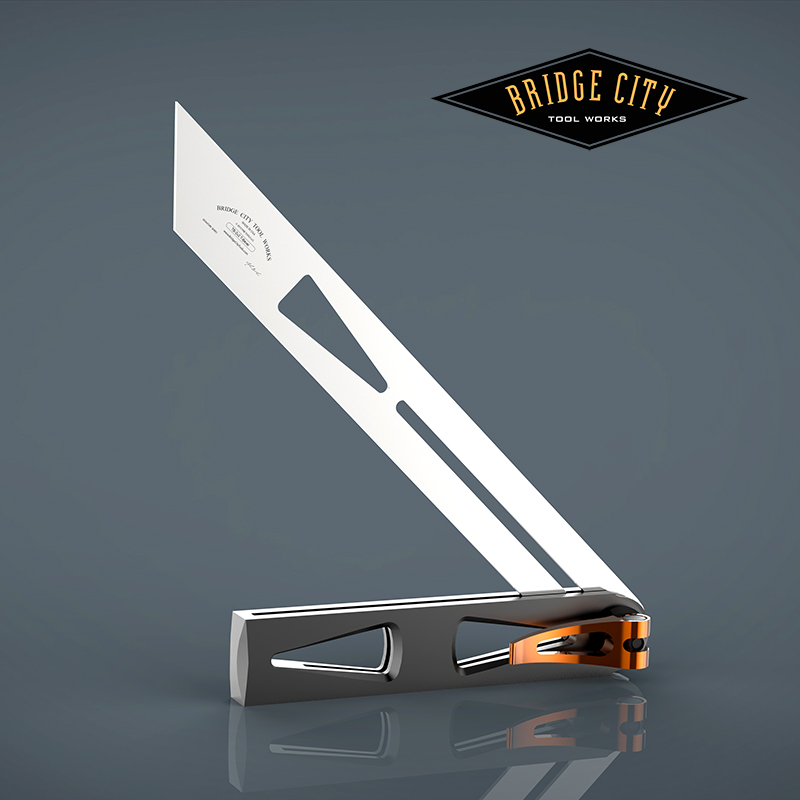
The TB-2 v2 Limited Edition in stainless steel;
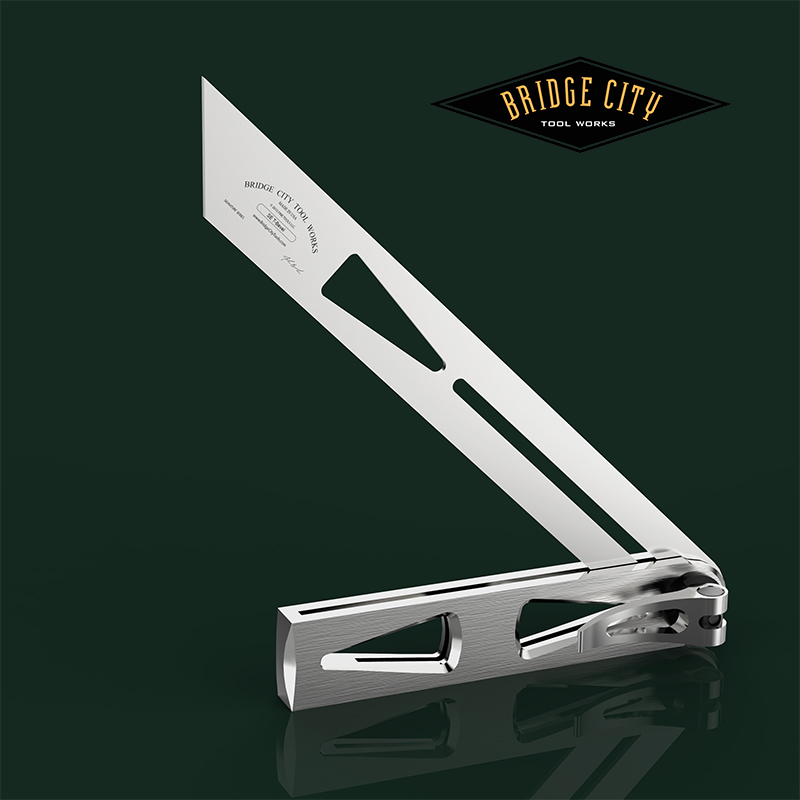
Anyway, we are really excited about these fundamental tools and hope you are too.
As many of you know, we have big event happening here in August and last week I was in a throwing away mood when I uncovered an intriguing box in our junk room prototype shop. Inside was the only remaining prototype of the VP-60 Variable Pitch plane. Lots of memories and it has now been put up for auction on eBay. If BCTW memorabilia or contemporary tool making is your thing, head on over to eBay.
-John

Notch for marking dovetails in an arc around a point?
Notch for marking dovetails in an arc around a point?
-Nope
John,
I’ll take a crack at a couple of the questions or riddles you have posed: the notch is for a pencil or scribe and you can set the blade for a distance from the body to score a line down your stock like a marking gauge; it could possible be used to mark an arc to if you set the lock a bit loose, although the blade might move in and out too; the cutout in the square gives a quick visual reference to which direction the blade points when grabbing it off the bench.
As for the knob on the side, the only drawback I can think of is that you can’t use it to set the complimentary angle of a miter gauge that is attached to a sliding saw table or crosscut table; a standard gauge could be taken off the table and the bevel set against the miter bar.
Okay, winning entries are now out of the way! I really like these new tools, the MT-2 is going to make a bunch of guys super happy- you know who you are, you didn’t order the CT-15 years ago and have been kicking yourself for it, so stop kicking and start ordering.
Best,
Rutager
P.S. I helped get the VP-60 over the $1,200 mark earlier today, I hope you raise enough from the sale to hire the bio-hazard team to clean out Michaels office in time for the open house.
Rutager-
BINGO on the notch as a quick marking gage substitute.
Negatory on the complimentary angle. Next time I see you, I will show you.
Lastly, it is a VP60 prototype, we think it is more important than the Magna Carta, but what do we know? 🙂
-John
John,
Okay, I actually took my TB-2 to my saw and discovered that it is a simple matter of setting the body on the one side of the fence and on the other side the blade would touch the fence instead, knob stays pointing at the sky, this would work in almost any situation, unless you were depending on the thinness of the blade to fit between the saw teeth or something similar. All of that aside, the cam clamp is the absolute best method of getting the bevel secure that I have ever used or seen.
I really don’t know why I continue to question you!
Regards,
Rutager
Rutager,
It’s a math thing… I am closer to 70 than I am 50. You can’t say that for quite some time. Be careful around the Tool Potentate Grasshopper…
– John
PS: Curious if you are old enough to understand the grasshopper reference….
John,
Yes, I do know the grasshopper reference, I also know the saying, “it’s a poor teacher who’s student doesn’t surpass them.” You better hope I start getting smarter!
On another subject, I was talking to Consuelo earlier today and was told there would be bacon based appetizers at the event and it just dawned on me that you are selling the prototype to finance all the bacon you expect I’ll consume, no worries, I will only eat what I think I can politely get away with- note to self: put baggies in pockets as bacon grease will soak through fabric.
-Rutager
John,
One more question, okay two before I go to sleep- got to get my beauty rest, you’ve seen me, I need as much as I can get; do you have any plans to make another plane that will have adjustable pitch? Would a block plane be a good candidate to have the pitch adjustable?
Thanks,
Rutager
OK. First: Awesome! An astounding array of beautiful and functional tools.
Second: it’s entirely possible that I’m an idiot, but I was using my TB-6 (end-locking) bevel the other day, along with my lovely Blue Spruce marking knife. I found that, no matter how hard I screwed down the locking mechanism, it would move when I was marking the line.Of course there are ways to hold the blade so that it wouldn’t move. But I confess to being surprised that it did (I don’t use bevel gauges much). Perhaps it’s just meant for pencil lines?
Which leads me to ask whether the cam-lock mechanism will be more secure than the end-lock mechanism? I’m guessing that the knob mechanism is more stable than the end-lock (not sure why, but my gut tells me that the length of the screw must have something to do with it). So perhaps the cam-lock will be just as secure, but easier for us old farts with failing fingers?
I’m not sure that you said, but what are the blade dimensions on the TS-1 v2? I love the idea of using it as a story stick. I hardly ever measure anything, but having something to make accurate marks on is always useful!
Nice work, as always!
— Peter
Peter-
Without seeing how you are working, it is hard to comment on the blade slip of our bevel. That said, it is a lever and has a yield point.
Because the cam lock of our new bevel is user adjustable, I would be surprised if there is a better way to pinch a blade. I could be wrong. Those that own the CT-15 have commented that it is the best locking bevel they have ever used to which I will add my name to the list.
The TS-1 v2 is 5″ heel to toe.
-John
PS- Thanks for the kind words regarding our new tools!
Rutager,
The VP-55 is coming… and that is all I am going to say about that!
The CT-17 is two pitches and from my experience, that really is all that is needed for the majority of tasks. One can add pitchs to that plane by skewing it in use. We published a chart on this years ago and I cant find it.
-John
John,
Even though the blade won’t have graduations, can you make a metric version for Fred and Paul-Marcel that is 12.7cm heel to toe, rather than the 5″ of the standard square?
I can’t say enough good things about how rigid the cam lock mechanism is and if I remember, I’ll pull out my CT-15 and marking gauge and give it a test- pretty sure it will pass.
VP-55, can you say anymore about it?
Best,
Rutager
“Even though the blade won’t have graduations, can you make a metric version for Fred and Paul-Marcel that is 12.7cm heel to toe, rather than the 5″ of the standard square?”
And what will this request solve?
“VP-55, can you say anymore about it?”
The name says it all. And that is all there is to say about that!
-John
John,
Just poking some fun at our metric loving friends- 12.7cm is 5 inches, same square, just by calling it metric, Fred will buy one of each!
VP-55 a bit shorter than the VP-60, or a little less range? Will it be available in metric also?
-Rutager
Peter,
Pulled out the CT-15, couple other bevels and a marking knife; the standard bevels both end and knob locking didn’t hold, the CT-15 did and I made several parallel lines and then I realized that the CT-15 is only about half the length of the others, so it had an unfair advantage as the “lever” is longer on the standard bevels, so I made it a fair contest by just marking from the shorter distance- still slipped! I simply can’t say enough good things about how rigidly held the blade is with the cam lock. I was going to order one of each, but since having multiples on hand for a challenging project is ideal, I may need to get another.
John,
Bravo on the cam mechanism; best thing to happen to a bevel yet.
-Rutager
Speaking of Mastodons in Iowa, I challenge that even cave men have a sense of preference. We like heavy clubs with big ends. We like our women with long hair, and we like our bevel gauges with end locks…and that is all I have to say about that!
By the way, give a shout out to my old buddy Fred – he is in the dumps – his nurse is procrastinating.
Oh – and your new tools are cool John!
DJ
Just wondering why on squares like this that the “handle” is always stopped way short from the top edge of the blade.
I understand you need clearance for marking but it seems you could extend the handle up a bit more for more registration.
Recently on small stock I was having trouble holding the square securely to the wood, if that makes sense.
Paul
Paul,
Great question! We do it for corner clearance primarily, but in the case with blades with graduations, readability is the driving factor.
Corner clearance is important, deformed wood from overly tight joints and glue squeeze-out are the culprits.
– John
Rutager – thanks for doing the experiment. You’re a great salesman! I’ll need to think about this some more…
Where do we stand on the “Bridge City Essentials” these days? Aren’t we still short a few tools (even counting Rutager and Fred)?
— Peter
Darn, can’t add attachments to the comments area. I had made a little sketch of what I was thinking.
Instead try to picture this.
The handle or whatever you call it extends almost to the top of the blade. Now instead of a putting a 90 degree angle on the handle you make it 75 or so to angle it back and give you your corner clearance. I get my extra meat on the front of the handle, you get your corner clearance in the back. The graduations I think should still be unaffected.
Paul,
Got it. What application benefits from this modification?
-John
Agreed it may be marginal but on stock that’s tending toward smaller the more of the handle that touches the stock more stabile it becomes.
Again, if I could attach something it would be clearer.
I don’t know about others but I prefer to use the outside of the blade to scribe/mark against. And if I understand right, the inside of the blade is the more true of two ? To me the outside is easier to use.
Paul-
Old try squares with a brass inside face were only squared on that face. Old, all wood handled try squares were squared on the inside face only. This was the impetus for starting BCTW 30 years ago as I did not know the convention and always assumed both were 90 degrees. Look at the mess this has caused me!
Regarding our squares, it does not matter, all are warrantied to be within 0.002″ over the length of the blade, regardless of the length of the blade inside and out. And yes, generally speaking, marking against the outboard edge of the blade is generally easier and faster.
If you can attach a sketch to an email, send it to me; john@bridgecitytools.com and we can discuss your idea.
-John
John,
Unless I’m mistaken (and I’ve checked the comments twice with my good eye), nobody’s yet correctly answered your query about the orange/black insert in TS-1 v2.
I’m going to take a whack at it: is it for expansion relief so that the handle doesn’t twist or rack?
I wish I had a second or better guess, but I’m not that kind of smart (other kinds – sometimes).
Thanks,
Joe
OK: I acquiesce. I LIKE these bevel gauges and perhaps it is time to change my old paradigm… John, I remember laying out dovetails on relatively thin stock and having an old side lock bevel gauge get in the way. I have a habit of using hold fasts on my work so often the work is pinned to the bench top and with the end clamped gauge, there is only the gauge shoulder thickness to worry about when you flip it from left hand to right hand marks. with the added side tab there is too much thickness to fit. Again, this is my problem because (probably) everyone else clamps their work in a vice where this would be a total non-issue. When I had this problem, I then found my old Stanley end lock bevel gauge and fell in love with it. NOTE: this was all well before Bridge City Tools entered my awareness. Since then, I have just kept using this old gauge as my mainstay.
I am thinking though that (as I said above) it may be time to start listening to my fellow DSN and stop obsessing :~)
Dennis
I’m thinking the orange insert is the OSU Beaver’s color…
— Peter
P.S. I LOVE my CT-17! Every time I use it, I love it more!
🙂 Nice guess but no, that is not the function.
– John
John,
I got it; the cut out that is. It is there so that you can slip a couple fingers or a thumb in there to hold it tight to your stock while marking square. Second function, more of a happy coincidence, but maybe just as important is that it amuses you to see the DSN try to figure things out!
Best,
Rutager
Rutager:
Insert the annoying buzzer sound of failure here. The cutout is ergonomic, the purpose of the orange or black insert is …. ?
– John
John,
Well, it’s a tough question without actually touching the square and feeling the insert, but my second (and final) guess will be a soft grip to help pinch the square against the workpiece.
Joe
…to make it sexy!
Annoying buzzer sound of failure. Forever to be known as ABSF.
Annoying Buzzer Sound of Failure!
I hear that sound in my sleep.
I’m pretty sure the black insert was to pacify some nut job in St. Paul- something about making it look like the black chrome tools. The orange I’m thinking is for the BCTW logo color in honor of 30 years.
ABSF!
It fills a hollow created to balance out the square?
And, the insert glows in the dark for late night romps in the shop!
ABSF!
I guessed before: it covers the interior seam where the two halves of the handle meet and lends some additional stability to thE joint between the halves at a lower point than the four screws, preventing shifting.
I can hear it now: ABSF!
Matches your leisure suit?
Anodizer made you a deal you couldn’t resist on some overstock?
Halloween is your favorite holiday?
Caldor keeps telling you the knock- knock joke with the punch line of “orange you glad I didn’t say banana?”
Mafia controls the Portland CNC market and “politely” asked you to add a few more machining steps to your new tool? Knee feeling better yet?
Back to some more serious, but probably just as wrong guesses: the insert is used to register the handle halves together; or in the case of the TS-2v2 to keep the graduations in proper orientation to the handle when squaring the tool.
ABSF!
I don’t want to break my buzzer, so here is the solution!
The inserts in our new square are there so we can disassemble the two halves if need be. The top half of the two handle components pinches the blade and are held together with screws, the bottom half is held together with steel dowel pins. The insert provides a lip for a custom made tool to press the two halves apart.
The dowel pins are how we keep the working surfaces of the handle dead parallel.
And it looks really, really cool!
– John
Never would have guessed that- like the forward thinking in case of the off chance service is needed. Design with a hidden purpose, now that is cool!
Dagnabit! I was just about to start guessing! My first guess was that it was something to allow the square to accommodate temperature changes without distorting the square from true, or causing the seams to become offset.
Bummer. Seemed like a good guess at the time. Not as good as Rutager’s, of course.
Still looking forward to holding one of the squares!
— Peter
Peter,
Here is your ceremonial ABSF!
– John
Whew! I was thinking I might miss out on my ABSF! Thank goodness!
— Peter
John: Off topic: if we’d like to use the forum, but don’t want our email addresses visible, is there a way to do that? I looked at the FAQ and the forum settings and couldn’t find an answer.
On topic: I got a load of that desk on Twitter. Purdy!
Thanks, Dave “Heatwave” Markowitz
Comment 50: is this a DSN record? I just thought it was there to look cooler.
Dave-
Michael has fixed your login I believe.
-John
Thanks, John!
Alex,
50 posts a record for the DSN? Not a chance; the Kerfmaker caption contest ran 172 posts, I think that one was the highest.
-Rutager